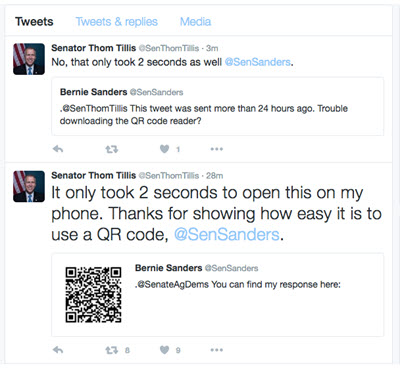WASHINGTON, July 8, 2016 - A national GMO disclosure bill is now one step away from getting to the White House.The Senate’s final 63-30 vote to approve the bill late last night now sends the legislation to the House next week.
Industry groups already have started lobbying House members to approve the legislation as-is, even though many originally didn’t like the idea of mandatory disclosure.
The House GOP leadership is trying to figure out the best way to deal with the legislation. One big question is how many hardline conservative Republicans will object to voting for the bill unless they’re allowed to offer amendments. Some conservatives also may heed the Heritage Foundation’s criticism of the Senate compromise and oppose the bill because it would mandate disclosure of biotech ingredients.
The ranking Democrat on House Agriculture Committee, Collin Peterson, says the bill should get significant support among House Democrats in excess of the 45 who voted for the House version last summer. Only 12 Republicans voted against that House bill, which passed by a wide margin, 275-150. “I think it's the best we can get,” Peterson said of the measure.
Senate Agriculture Chairman Pat Roberts called last night’s Senate action “the most important vote for agriculture in the last 20 years.”
He said the legislation “allows farmers to continue using sound science to produce more food with less resources, gives flexibility to food manufacturers in disclosing information, and gives access to more food information that consumers demand.”
Battle of the QR code. Two senators took their debate over GMO disclosure to Twitter. Vermont Sen. Bernie Sanders wanted to make a point that digital disclosure isn’t sufficient for biotech ingredients, so he posted a QR code on Twitter Wednesday night that he said could be used to read his thoughts on the bill. North Carolina Sen. Thom Tillis responded Thursday with a tweet that said, “It only took 2 seconds to open this on my phone. Thanks for showing how easy it is.”
Not to be outdone, a Sanders tweet responded that the QR code had been posted more than 24 hours earlier and asked Tillis whether he had trouble downloading the code reader. Tillis shot back: “No, that only took 2 seconds as well.”
For curious readers, the Sanders QR code (below) leads to
a press
release

House leaders pledge action on Cuba ag trade. A leading congressional proponent for increasing food exports to Cuba says he has a commitment from House leadership to take up a U.S.-Cuba agricultural trade bill. A spokesman for Rep. Rick Crawford, R-Ark., says he hopes to move the legislation by the end of the year.
Crawford proposed an amendment this week to an appropriations bill to lift restrictions on private financing of exports to Cuba. But he withdrew the amendment after getting a “strong commitment” from the House leadership and the south Florida delegation to “pursue a long-term solution” that will permanently open up agricultural trade to Cuba. Three House committees will have jurisdiction over the bill: Agriculture, Foreign Affairs and Ways and Means.
“This path forward is a major victory for American producers who wish to sell their commodities into the island nation’s market, which is estimated to be worth in excess of $1 billion annually,” Crawford said.
Ben Mosely, vice president of government affairs for USA Rice, says the pledge Crawford obtained leaves his group “optimistic that the barriers will be addressed this year."
GAO: Agencies improperly overlooking unauthorized grazing. Ranchers who graze federal lands without authority routinely get by without being citied for violations, according to congressional investigators. The Government Accountability Office says that the Forest Service and Bureau of Land Management took action in 1,500 cases of unauthorized grazing between from 2010 through 2014. But the GAO says that most such incidents go unrecorded because the agencies never cite the producers for a violation.
The auditors say the agencies don’t have the legal authority to do it, but they routinely resolve incidents without taking action against the producers. GAO’s recommendations included a proposal to the Forest Service to raise its fines so that they serve as a better deterrent.
Agency field staff told GAO that, for now, there are only a small number of confrontational ranchers who don’t recognize federal authority over the land, but that problem is expected to grow.
Ready for a break? It’s Friday and after a long week, you probably wish you could be in the great outdoors, perhaps watching brown bears hunt along Alaskan waterfalls. Not in your budget or travel schedule? The National Park Service, in partnership with explore.org can help with their Bearcam. With just a click of your mouse, you can watch exclusive live footage of bears fishing along Alaska's Brooks River in Katmai National Park.
Over a hundred brown bears annually descend on a mile long stretch of Brooks River to feast on the largest sockeye salmon run in the world. And the park service has them identified, too. All of the bears who are tracked by NPS biologists have a number and, in some cases, a nickname.
There’s Otis, who NPS says “uses some of the most efficient fishing techniques in the falls. Unlike many other bears, he is tolerant of other bears around him while he eats.” And Ted, who was first sighted in 2001 and is easily recognizable because of the distinctive scar on the left hip he received in 2007 from another bear named Ugly.
According to the park service, July is prime-time for bear watching and the animals are most active during daylight hours. And if this daily dose of bears isn’t enough of an outdoors experience, you can try live feeds like the Ospreycam in Maine or the SharkCam in CapeFear.
Sara Wyant contributed to this report.
#30
For more news, go to: www.Agri-Pulse.com

